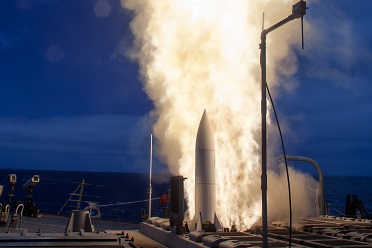Press Release
Test Demonstrates Standard Missile-6 Effectiveness and Versatility
Thu, 08/21/2014 - 15:24

Credit: U.S. Navy
WHITE SANDS MISSILE RANGE, N.M. — The Navy executed a successful flight test of the surface-to-air Standard Missile-6 (SM-6) at White Sands Missile Range Aug. 14.
During flight test “Juliet,” the Navy examined the missile’s ability to intercept a subsonic, low-altitude target over land. Juliet is one of 10 follow-on operational test and evaluation (FOT&E) events planned for SM-6’s missile performance and demonstration.
“This event demonstrated SM-6’s ability to detect and engage a slow moving target in the presence of complex land clutter,” said Jim Schuh, assistant program area manager for weapons in the Air and Missile Defense Mission Area at the Johns Hopkins University Applied Physics Laboratory (APL) in Laurel, Md. APL is one of the Navy’s SM-6 partners and provided technical leadership for the test. “It is another victory for this very versatile weapon.”
The SM-6 provides an over-the-horizon engagement capability when launched from an Aegis warship. It uses the latest in hardware and software missile technology to provide needed capabilities against evolving threats.
“This is an important achievement for Naval warfare,” said Capt. Michael Ladner, Program Executive Office, Integrated Warfare Systems 3.0 Program Manager. “SM-6 is undoubtedly the most advanced anti-air missile the Navy has ever produced and delivered to our sailors.”
The SM-6 is the sixth variant of the Standard Missile family developed for the Navy with Raytheon Missiles Systems. Last June, Raytheon was awarded a $275 million contract modification covering SM-6’s all-up round production and its spares. The SM-6 program has been in development for seven years and achieved Initial Operational Capability in November 2013. It is now undergoing FOT&E, which is projected to be completed during the second quarter of FY16.
“Once again, the exceptional Standard Missile continues to evolve in order to provide critical new defensive capabilities, and we are proud to have contributed to these advancements,” said Conrad Grant, Head of Air and Missile Defense at APL. “APL’s long history of research and development with these and related systems helps our Navy sponsors and partners develop the strategic tools to protect our nation — not just today, but for the future.”
PEO IWS is an affiliated Program Executive Office of the Naval Sea Systems Command. IWS is responsible for spearheading surface ship and submarine combat technologies and systems, and for implementing Navy enterprise solutions across ship platforms. APL, a university affiliated research center (UARC), serves as the technical direction agent (TDA) for the Navy’s SM-6 development program.